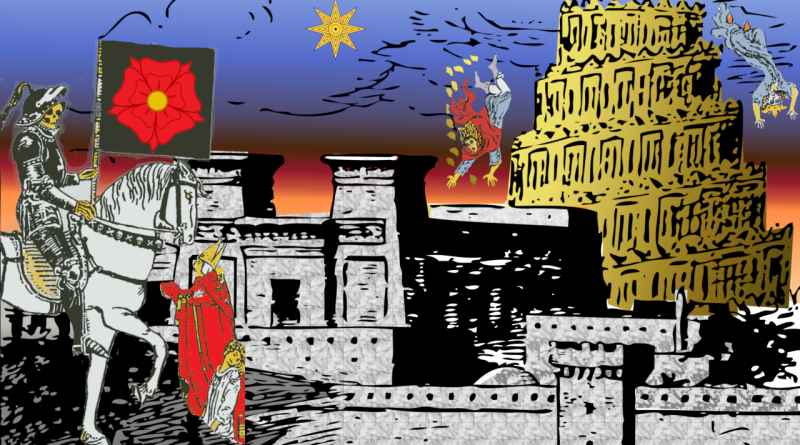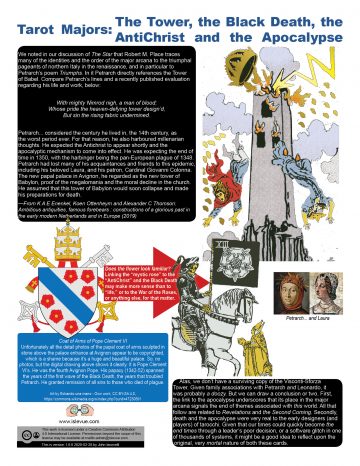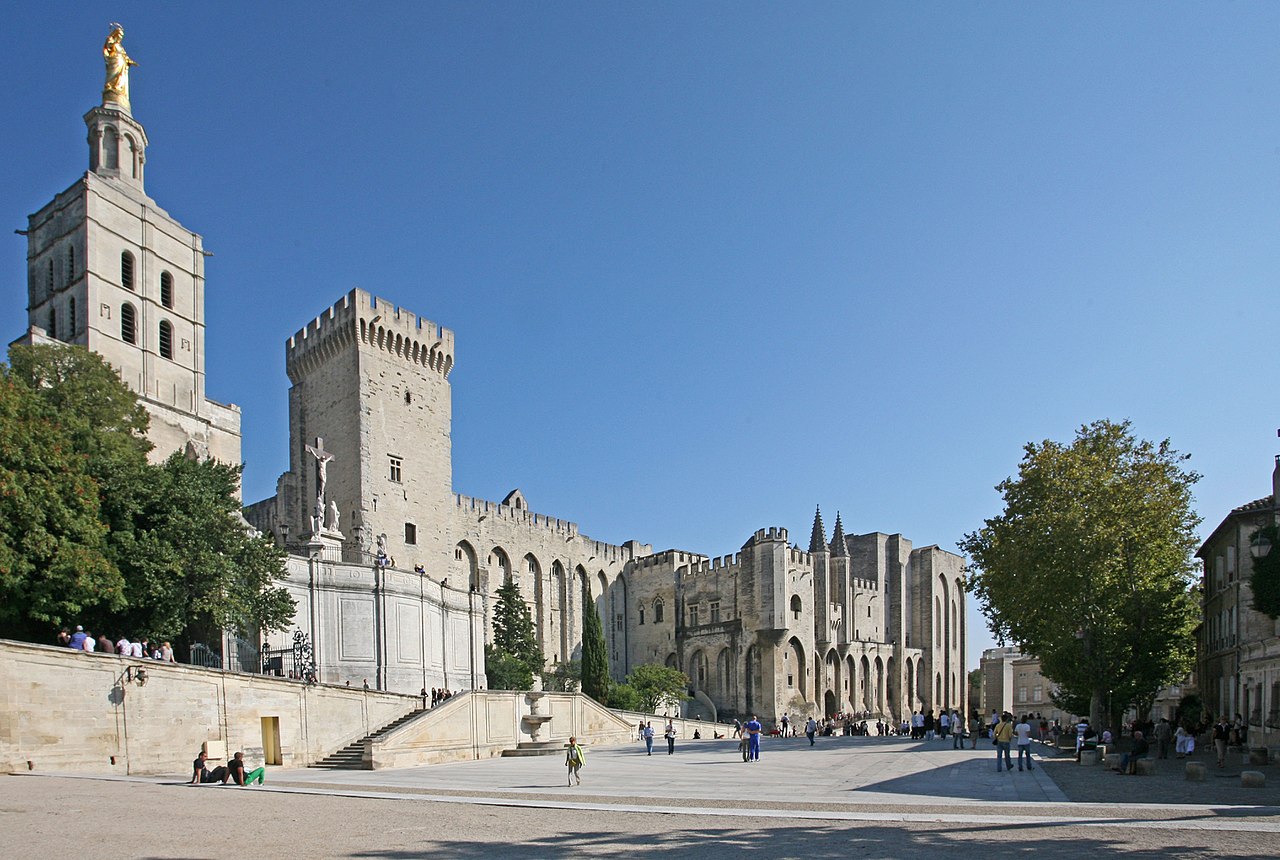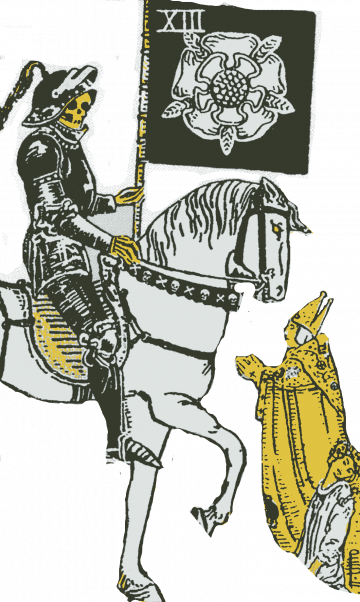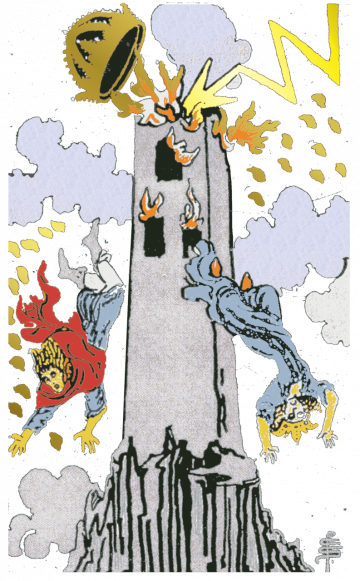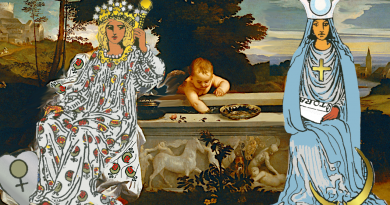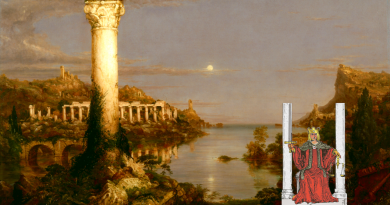The Tower, the Black Death, the Antichrist and the Apocalypse
The Library of Babel (1941) is a short story by Jorge Luis Borges. It tells of a fantastic library full of books containing every possible random combination of words and letters. By virtue of their random content, some books may contain great truths and useful facts while others may contain only gibberish. It is the fate of the librarians to search for the one book they believe will contain a perfect index of those truths and facts.
In a recent post, we cited Eliphas Lévi, who, in Transcendental Magic (1854) stated that "an imprisoned person with no other book than the Tarot, if he knew how to use it, could in a few years acquire universal knowledge, and would be able to speak on all subjects with unequaled learning and inexhaustible eloquence."
No doubt the symbols of the major arcana have accumulated, evolved, multiplied and mutated in the six hundred years of tarot history into something like the Library of Babel. Lévi, among others, may be said to perform a role similar to Borges’ librarians, promising that there is a concordance that brings it all together.
The Tower major arcanum has traditionally been associated with the Tower of Babel. For that reason we may wish to take particular care in interpreting its symbols, because in the manner that Babel’s language was said to be the predecessor of all languages that followed its demise, the Tower can be looked at as a fulcrum point in the progress of the majors, with all following it different-in-kind than all that preceded it.
The post continues a format—one page, one basic thought—depicting a single aspect of a major arcanum. So much has already been written about each of the major arcana, I see no need to repeat the general literature.
The format centers around a graphic, usually featuring the card itself, that sheds light on a single factor that helps make that arcanum what it is, along with (hopefully) a brief amount of text. Note the higher quality PDF download will be easier to read. Most of the text in the main section below repeats the text in the PDF. The text here may also include links which are not present in the PDF.
The Library of Babel
We noted in our discussion of The Star that Robert M. Place traces many of the identities and the order of the major arcana to the triumphal pageants of northern Italy in the renaissance, and in particular to Petrarch’s poem Triumphs. In it Petrarch directly references the Tower of Babel:
With mighty Nimrod nigh, a man of blood;Whose pride the heaven-defying tower design’d,But sin the rising fabric undermined.
Now, compare Petrarch’s lines and a recently published evaluation regarding his life and work, below:
Petrarch… considered the century he lived in, the 14th century, as the worst period ever. For that reason, he also harboured millenarian thoughts. He expected the Antichrist to appear shortly and the apocalyptic mechanism to come into effect. He was expecting the end of time in 1350, with the harbinger being the pan-European plague of 1348. Petrarch had lost many of his acquaintances and friends to this epidemic, including his beloved Laura, and his patron, Cardinal Giovanni Colonna. The new papal palace in Avignon, he regarded as the new tower of Babylon, proof of the megalomania and the moral decline in the church. He assumed that this tower of Babylon would soon collapse and made his preparations for death.From K A E Enenkel, Koen Ottenheym and Alexander C Thomson: Ambitious antiquities, famous forebears : constructions of a glorious past in the early modern Netherlands and in Europe (2019)
The connection between the Black Death, the Antichrist and the apocalypse, if this is indeed Petrarch’s view, is the Tower. And if Petrarch, having influenced the triumphal parades of Northern Italy and the designers of Tarot, identifies a specific location, we might do well to look further at the tower he is said to have focused on.
As one can plainly see, the Papal Palace in Avignon is a massive complex. During the fourteenth century, six Popes were elected, reigned and lived here. Of the six, Pope Clement VI was known as the most extravagant, and it is he that Petrarch wrote of.
Pope Clement VI was the fourth Avignon Pope. His papacy (1342-52) spanned the years of the first wave of the Black Death, the years that troubled Petrarch. He granted remission of all sins to those who died of plague. Since he appears not to have made ability to pay a precondition of the remission, he probably couldn’t have been that bad a guy. Clement, however, is probably most notorious for declaring the ability of the Pope to sell indulgences, perhaps the chief complaint which led to the Protestant Reformation. Note the link here between this alleged Antichrist and the "treason" of the head of the Capuchin order, who defected to Lutheranism, whom we mentioned in the discussion of the Hermit.
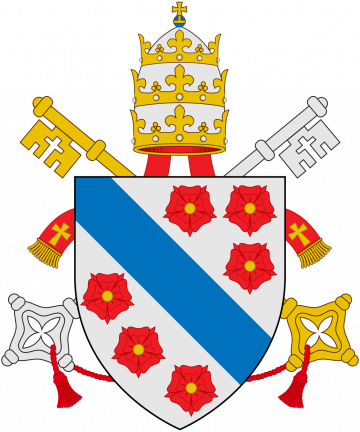
It is Clement’s papal coat of arms (above; note also that each Pope had a different coat of arms; they may still do) that we focus upon. Unfortunately all the detail photos of the papal coat of arms sculpted in stone above an entrance at Avignon appear to be copyrighted, which is a shame because it’s not only beautiful but interesting and relevant to tarot studies. The digital version, however, shows the flowers quite clearly.
No doubt knowledgeable tarot practitioners are looking at the flowers on Clement’s coat of arms and thinking there’s something familiar about them. They have the same shape as the flower on the banner that Death carries in the RWS deck. The sculpted flowers on the Avignon palace are of light gray stone, so the resemblance is even more dramatic. The sculpture also includes two acolytes kneeling below the coat of arms, so the effect is reminiscent of the traditional depiction of the Hierophant/Pope.
In the Pictorial Key to the Tarot, Waite calls this flower the "mystic rose." This term is sometimes used for the Virgin Mary, though in fact the five petaled rose was linked to female deities such as Hecate going back thousands of years. In tarot literature, it has sometimes been said to signify “life.” It has also been linked to the War of the Roses.
The "life" and "goddess" aspects can certainly explain a view of the Death arcanum as signifying a rebirth rather than an end. But then again, following Death, we still must go through Temperance, the Devil and the Tower before we arrive at the dawn (the Star). Shouldn’t we see a clearer sign of a "new beginning" following a rebirth?
Returning to Petrarch’s view of Avignon, using this symbol to join the "Antichrist" and the Black Death may make more sense in the context of the meaning of the Tower.
The question then becomes, would Waite have known of the rose on the Palais des Papes? There is every reason to think he would. First and foremost, because he was intensely interested in Christian symbolism. Secondly, his interest in floral religious symbols in particular was well established, as visually evidenced in the Two of Wands, and conceptually in the rosy cross. Thirdly, his interest in Masonic and Rosicrucian history touched upon Avignon (writing about a Masonic group based in Avignon called "The Illuminati of Avignon" of all things, in his "A New Encyclopaedia of Freemasonry" of 1921). It is difficult to believe that Waite could have done any research at all into Avignon without having stumbled across one of the largest and most famous Gothic buildings in Europe, though of course the publication date of that book is after the publication of the RWS deck.
On the down side, if we interpret Death as carrying the banner of the Antichrist, and not of Life/Resurrection, it makes for a much harsher reading of Death than most modern tarot readers probably are accustomed to. Perhaps as consolation, it does provide a marvelous mirror image to what is sometimes said to be Jesus with the bloody banner of Revelations, as depicted on the RWS Sun major arcanum.
The connection between Clement VI and the mystic rose is a minor piece of the puzzle, but an illuminating one, as it throws additional light upon the explanation of The Tower. Alas, we don’t have a surviving copy of the Visconti-Sforza Tower to compare. Given family associations with Petrarch and Leonardo, it was probably a doozy. But we might still be able to draw a few conclusions.
- First, the links between the Antichrist and the apocalypse underline that the Tower’s place in the major arcana signals the end of themes associated with this world. All the major arcana that follow shall be related to Revelations and the Second Coming.
- Secondly, that death and the apocalypse were very real to the early designers (and players) of tarocchi. Given that our own times could quickly become the end times through a leader’s poor decision, or a software glitch in one of thousands of systems, perhaps it might be a good idea to reflect upon the original, very mortal nature of both these cards. And in fact, at the time of this writing, a virus looms as a possible world pandemic in the same way that the Black Death loomed over Europe in the fourteenth centure.
- Finally, if we assume that Waite knew of the Petrarch/Avignon/Antichrist/rose links, this re-use can be seen as a peek into Waite’s “curation” process. It could be said to be a re-use of a veritable Library of Babel-like "collection" of historical tarot symbols in aid of Waite’s seeming endeavor to inject modern Christian mysticism into the tarot that he and Colman Smith popularized so successfully.
In the end, "Librarian" Waite, not having found the book containing the perfect index, cuts and pastes symbols from the "randomized" books in order to make his own imperfect index.
Ambitious antiquities, famous forebears : constructions of a glorious past in the early modern Netherlands and in Europe Copyright ©2019 by K A E Enenkel, Koen Ottenheym and Alexander C Thomson
Feature image background drawing by Clker-Free-Vector-Images from Pixabay
 This article’s content by John Iacovelli, for islevue.com is licensed under a Creative Commons Attribution 4.0 International License. Permissions beyond the scope of this license may be available at mailto:admin@islevue.com.
This article’s content by John Iacovelli, for islevue.com is licensed under a Creative Commons Attribution 4.0 International License. Permissions beyond the scope of this license may be available at mailto:admin@islevue.com.
